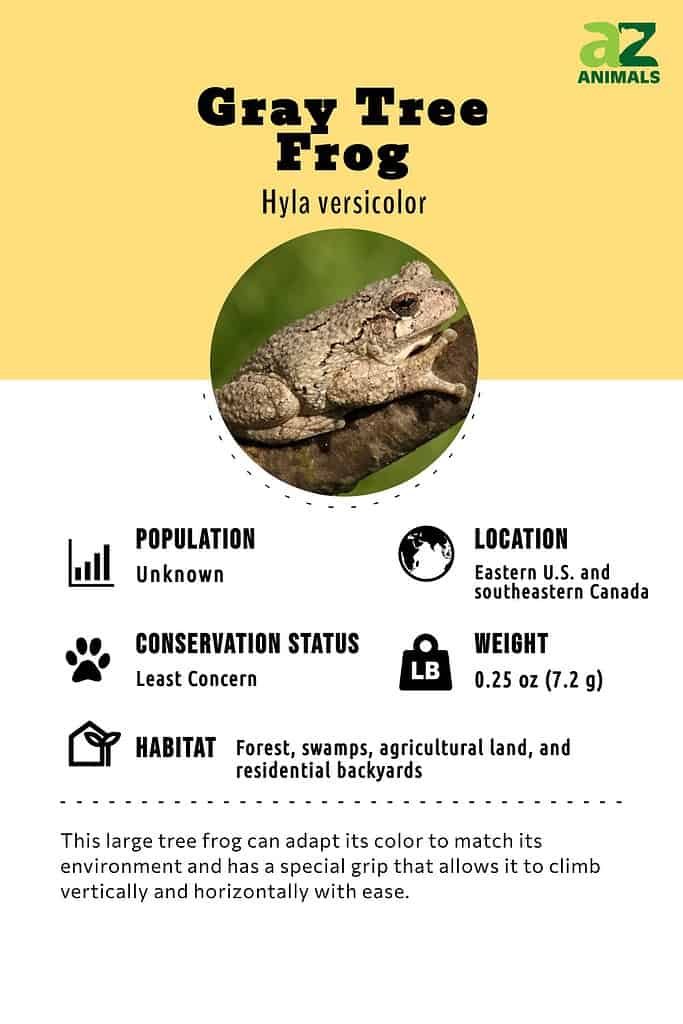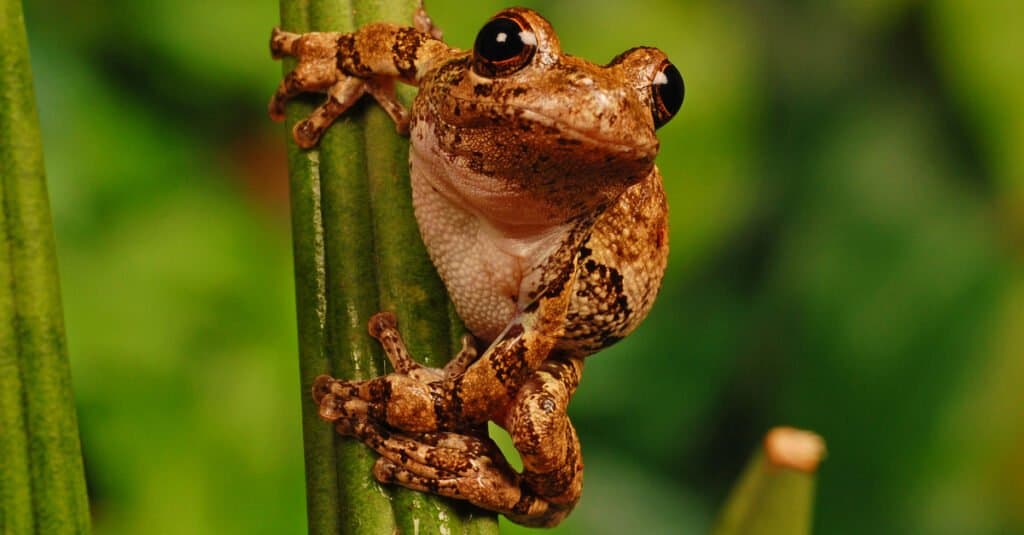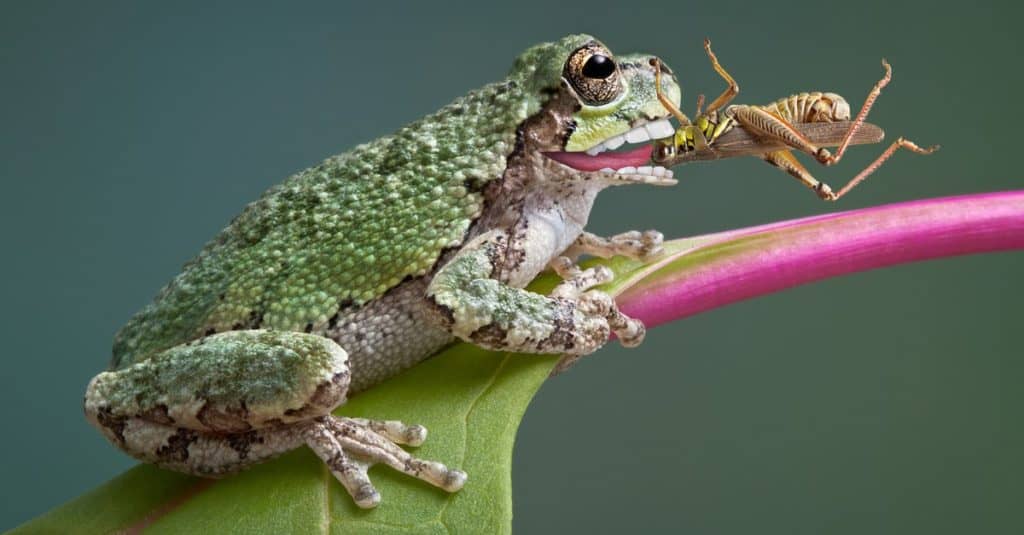Gray Tree Frog
Hyla versicolor
This frog can "freeze" itself by making glycerol that becomes glucose, which acts like antifreeze and stops its heartbeat and breathing!
Advertisement
Gray Tree Frog Scientific Classification
- Kingdom
- Animalia
- Phylum
- Chordata
- Class
- Amphibia
- Order
- Anura
- Family
- Hylidae
- Genus
- Hyla
- Scientific Name
- Hyla versicolor
Read our Complete Guide to Classification of Animals.
Gray Tree Frog Conservation Status
Gray Tree Frog Facts
- Prey
- Insects, spiders, plant lice, snails, slugs, mites
- Name Of Young
- Tadpole
- Group Behavior
- Solitary
- Fun Fact
- This frog can "freeze" itself by making glycerol that becomes glucose, which acts like antifreeze and stops its heartbeat and breathing!
- Estimated Population Size
- Unknown
- Biggest Threat
- Habitat loss
- Most Distinctive Feature
- Changes color based on temperature and environment
- Gestation Period
- Eggs hatch after 3-7 days, depending on water temperature
- Average Spawn Size
- 1,000-2,000 eggs in groups of 10-40
- Habitat
- Forests, swamps, agricultural land, residential backyards
- Predators
- Birds, snakes, small mammals, other frogs
- Diet
- Carnivore
- Type
- Amphibian
- Common Name
- Gray tree frog
- Number Of Species
- 1
- Location
- Eastern U.S. and southeastern Canada
Gray Tree Frog Physical Characteristics
- Color
- Brown
- Grey
- Green
- Lifespan
- 7-9 years
- Weight
- 0.25 oz (7.2 g)
- Length
- Males are 1.25-2 in (32-52 mm) and females are 1.5-2.25 in (38-60 mm)
- Age of Sexual Maturity
- 2 years
- Age of Weaning
- 45-65 days for metamorphosis from tadpole
View all of the Gray Tree Frog images!
The gray tree frog can vary its color to match its environment and appear gray, green, and brown!
The gray tree frog is a large species of tree frog that can take on many colors despite its name. It is commonly found in southeastern Canada and the eastern United States. The gray tree frog spends most of its life high up among the trees and is very adept at navigating the branches thanks to its sticky feet.

4 Incredible Gray Tree Frog Facts
- This tree frog varies its color to match its environment, such as being darker to match tree bark.
- The grey tree frog slows down its metabolic processes in the winter and essentially freezes until spring.
- These frogs are an essential part of its ecological niche.
- They secrete a slightly poisonous toxin from their skin.

The gray tree frog is able to change its skin color to match its environment.
©Chris Hill/Shutterstock.com
Scientific Name
The gray tree frog’s scientific name is Hyla versicolor, which is derived from the Latin for “variable color” due to its ability to alter the color of its skin based on certain factors, such as being a lighter shade at night and a darker tone during the day. It belongs to the Hylidae Family and Amphibia Class.
Other common names for the gray tree frog are the eastern gray treefrog, northern gray treefrog, common gray treefrog, and tetraploid gray treefrog.

is from the Latin for “variable color.”
©Deatonphotos/Shutterstock.com
Evolution and History
Genetic studies have shown that the gray tree frog evolved due to “multiple hybrid events” involving ancestors that have two sets of chromosomes. The species has been found to have DNA from Cope’s gray tree frog (H. chrysoscelis) and two other species that are now extinct but most likely were present in the northeastern and northwestern parts of the gray tree frog’s range.
These frogs are almost indistinguishable from the Cope’s gray tree frog. The Cope’s gray tree frog has the same appearance as the gray tree frog and can only be identified by a slightly slower call. They are otherwise completely separate species, with the gray tree frog having twice as many chromosomes as the Cope’s gray tree frog.
It’s uncertain how the gray tree frog evolved to be able to change color. Although it may seem like a chameleon in its abilities to adapt its color to match its environment in order to evade predators or as a reaction to the time of the day and related temperatures, there are several differences between the two animals. Apart from the frog being an amphibian and the chameleon a reptile, chameleons can change to a broader range of colors (including pink, orange, red, yellow, and blue), differing degrees of brightness, and combinations of tones. The chameleon is also faster at its color changes than the gray tree frog, and there are other reasons besides camouflage for it to shift shades such as for social signaling.

Cope’s gray tree frog looks virtually identical to the gray tree frog but is a different species.
©iStock.com/Coffee999
Appearance
These frogs are particularly unique because they are not necessarily always gray. Instead, their color variation can range from gray to green or even brown. It truly depends on its current environment and activities. It regularly alters its color to match tree bark, but its belly is usually always white. The gray tree frog is very warty in appearance.
These frogs utilize a special grip on their hands and feet that allows them to climb vertically or horizontally with ease on trees and other objects.
They are considered a larger example of a tree frog, being anywhere from 1.25 to 2.25 inches long depending on the sex. So on average, the frog is about three-and-a-half times as long as an aspirin tablet. Compared to other tree frogs, like the pinewood tree frog and squirrel tree frog, the gray tree frog has a weightier build.
Two distinct features of adult frogs are the light spot beneath the eye and the bright orange coloration on the inner thigh. This bright color variation probably serves as a warning to potential predators.

Gray tree frogs have a special grip on their hands and feet that allows them to easily climb vertically.
©Alan B. Schroeder/Shutterstock.com
Behavior
These frogs are solitary creatures and only spend time together during the breeding season. All other times of the year, they spend time hiding during the day and hunting during the night. During the day, they can be found disguising themselves under bark, rotten logs, leaves, and tree roots. It produces a sticky fluid from the tips of its hands and feet that allow it to climb into trees to hunt for food.
The male of the species has a loud and almost birdlike call. It will make this call for hours after dusk as a way to establish a breeding territory. The males can be aggressive, but generally only in the breeding season when they need to defend their territory.
They hibernate in the winter thanks to an adaptation that allows 80% of their body to freeze. They can survive extremely cold temperatures by hiding under rocks and other forest objects.

The male gray tree frog has a loud and almost birdlike call.
©Ryan M. Bolton/Shutterstock.com
Habitat
These frogs are common in the eastern part of the United States and parts of southeastern Canada. This includes northern Florida over to central Texas, as well as all of South Carolina and Georgia. Being tree frog, they can usually be found in wooded areas, whether that is a forest or agricultural area. They will not be found far away from either trees or a source of water, like a swamp or pond.
They spend most of their time in high treetops but can be identified in the vegetation of fishless wetlands during their breeding season. In the summertime, it is not unusual for people to see them on windows looking for the bugs attracted to artificial lights.

True to their name, gray tree frogs spend the majority of their time in high treetops.
©Steve Byland/Shutterstock.com
Diet
This species of tree frog mainly feeds on different types of insects, such as snails, spiders, beetles, and the larvae of those insects. It spends most of its days high in treetops, where it can easily find moths, tree crickets, ants, flies, beetles, plant lice, spiders, and mites. It is comfortable jumping between branches to seek out its prey. They are opportunistic and will eat smaller frogs if given a chance.

The gray tree frog mostly feeds on insects.
©Cathy Keifer/Shutterstock.com
Predators and Threats
These frogs are very common and probably have a large population. However, regional populations in both the United States and Canada have to deal with the threats of habitat loss, water pollution, invasive species, and chytrid fungus.
Different species of snakes, birds, small mammals, and even other frogs prey on these frogs. They spend most of their lives in the treetops to avoid these types of predators. They are also nocturnal and active at night to avoid predation.
A known threat to these frogs is pesticides and insecticides that they consume on insects. These chemicals may have harmful long-term effects.

One danger to gray tree frogs comes in the form of insecticide that may be on the insects they eat.
©PiggingFoto/Shutterstock.com
Reproduction, Life Cycle, and Lifespan
The breeding season occurs after the frog wakes up from hibernation, in late spring and early summer. Males will defend an area around a water source and call out after dusk to find potential mates. Females will lay eggs in masses at the surface following mating. Each female will lay somewhere between 1,000 and 2,000 eggs in batches of 10 to 40. The eggs hatch between 3 and 7 days.
Young frogs are called tadpoles and live in the pond or water source they were hatched in until they are 4 to 8 weeks old. Then they complete a metamorphosis process and become young gray tree frogs or froglets.
The frog’s lifespan is believed to be on average 7 to 9 years. This lifespan is similar for males and females.

The gray tree frog spends its time as a tadpole in the water source where it was hatched.
©Michael Benard/Shutterstock.com
Population
These frogs are known to be widely distributed across their habitat in the U.S. and Canada. However, there are no accurate counts of its population in any region. These frogs are listed as Least Concern on the IUCN Red List. Most scientists believe there to be a large population that is generally not in danger of extinction any time soon.

Gray tree frogs are widespread across their habitats in U.S. and Canada.
©Aleksandr Kondratov/Shutterstock.com
Gray Tree Frog FAQs (Frequently Asked Questions)
How do you take care of a gray tree frog?
A gray tree frog is a popular option for a pet frog. It is not a picky pet, and will easily adapt to small enclosure habitats. In the wild, it can survive extreme temperatures in the winter, which means it will be comfortable at room temperature.
What does a gray tree frog eat?
The diet of a gray tree frog consists of bugs, bugs, and more bugs. It stays up in the treetops for most of its life eating flies, beetles, slugs, spiders, and their creepy-crawly larvae.
Are gray tree frogs rare?
No, the gray tree frog is a very common frog species to see throughout the southeast area of the United States. It is not uncommon to notice them on windows in the evening eating bugs attracted to lights in residential houses.
Are gray tree frogs dangerous?
They are a little bit dangerous due to poisonous characteristics. This type of frog is known to secrete a toxin from its skin that causes discomfort to human’s eyes, lips, the mucus lining of the nose, and open cuts. This secretion is not very dangerous or poisonous, but anyone handling one of these frogs needs to thoroughly wash their hands afterward.
Can gray tree frogs swim?
No. Although they usually spend the breeding season near water to lay their eggs, gray tree frogs are like other tree frogs and do not swim. Once they morph from tadpoles to froglets, they will retain water using shallow areas of water.
What does a gray tree frog sound like?
Male gray tree frogs usually call out a loud sound for hours during the breeding season. The sound of a gray tree frog has been compared to a bird, being a melodious trilling.
How long do gray tree frogs usually live?
The lifespan of a gray tree frog is typically 7 to 9 years, although they can live longer when kept as pets in captivity.
Thank you for reading! Have some feedback for us? Contact the AZ Animals editorial team.
Sources
- Schalk Lab / Accessed February 21, 2021
- University of Maine / Accessed February 21, 2021
- Department of Natural Resources / Accessed February 21, 2021
- Nature Works / Accessed February 21, 2021
- Smithsonian's National Zoo & Conservation Biology Institute / Accessed February 21, 2021
- Indiana Department of Natural Resources / Accessed February 21, 2021
- Virginia Herpetological Society / Accessed February 21, 2021


















